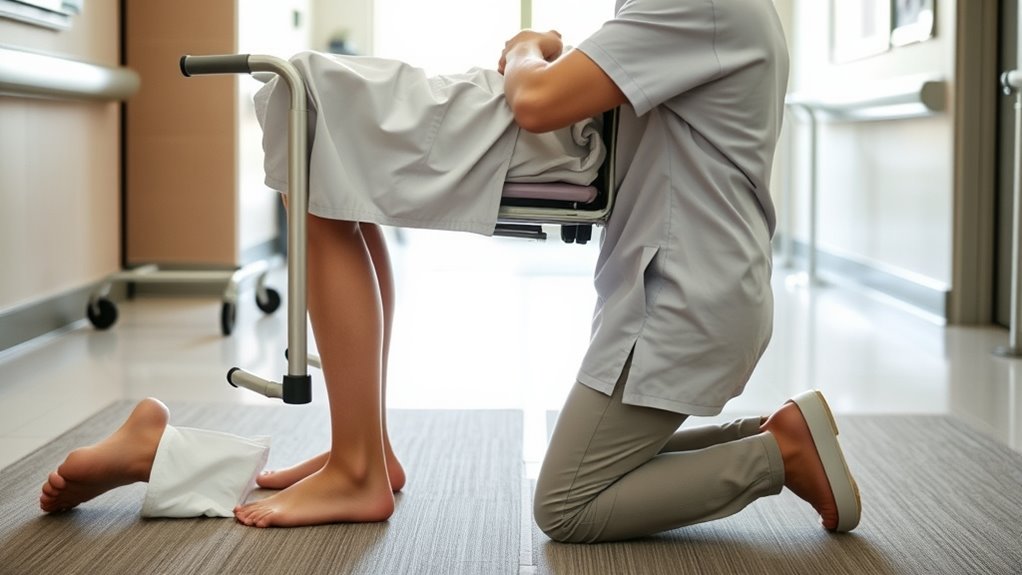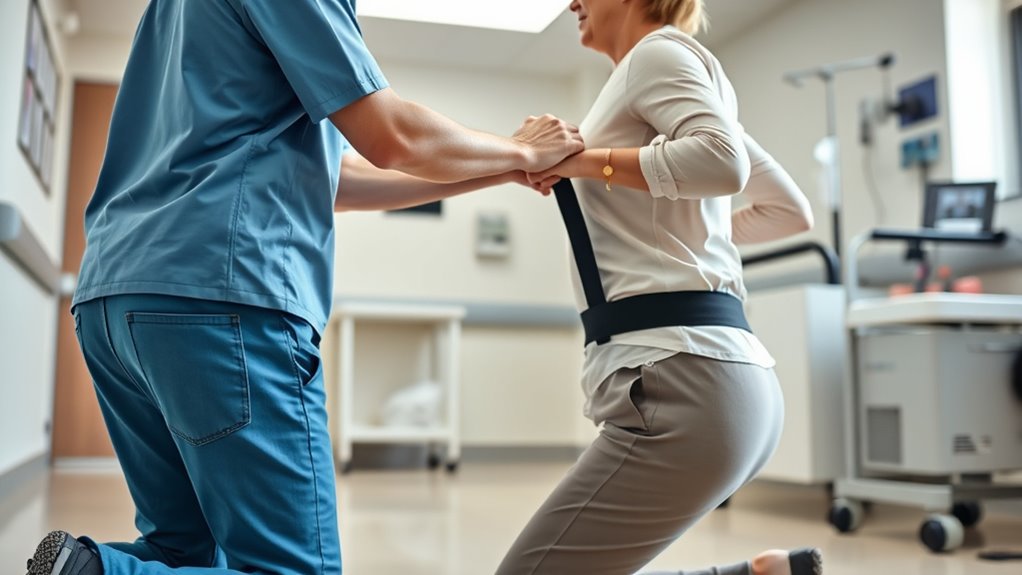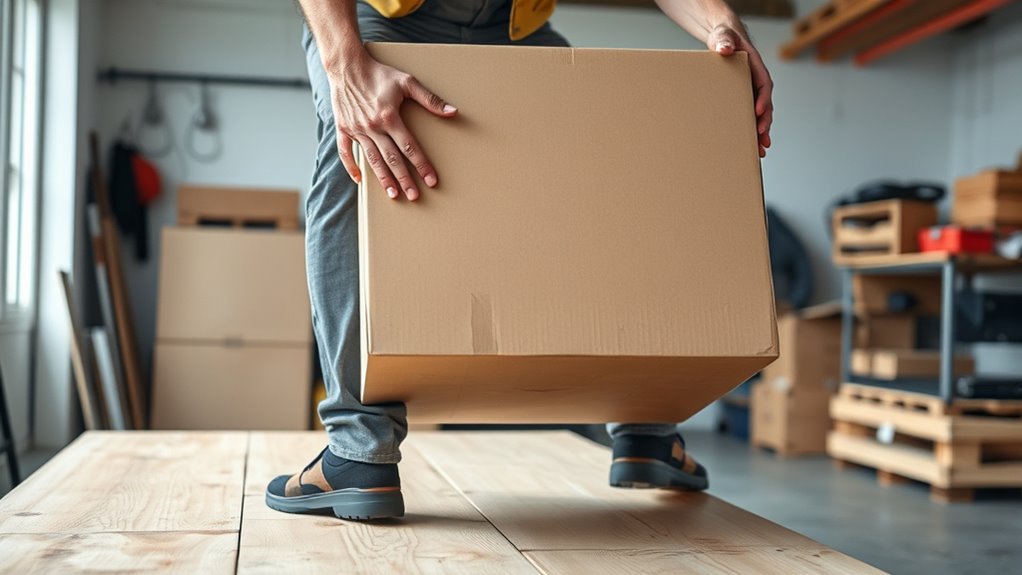To lift and transfer loads safely, assess the object’s weight, shape, and stability first. Plan your route and clear obstacles to guarantee a steady path. Use your legs, not your back, by bending hips and knees, and keep the load close to your body for better control. Maintain a balanced posture and communicate clearly with others. Practicing ergonomic exercises can further help reduce injury risks—keep going to discover more helpful tips.
Key Takeaways
- Always assess load weight, shape, and stability before lifting to identify hazards and plan safe handling.
- Use proper body mechanics: bend at hips and knees, keep back straight, and lift with leg muscles.
- Keep loads close to your body to reduce strain and improve control during transfers.
- Communicate clearly with team members using verbal cues and non-verbal signals for coordinated lifting.
- Ensure pathways are clear of obstacles and use ergonomic aids like transfer belts or sliders for safe handling.
Assess the Load Before Lifting

Before lifting, it’s essential to evaluate the load to guarantee it’s safe to handle. Start with a thorough load assessment, checking its weight, shape, and stability. This step helps you identify potential hazards and determine if the load is manageable. Conduct a risk evaluation by considering how the load’s size and position could affect your balance or cause strain. If the load feels heavy or awkward, seek assistance or use mechanical aids instead of risking injury. Remember, rushing the assessment can lead to accidents or muscle injuries. Taking a moment to analyze the load ensures your safety and prevents unnecessary strain. Always prioritize proper load evaluation before lifting to maintain ergonomic safety and reduce the risk of musculoskeletal problems.
Plan Your Movement and Path

After evaluating the load, the next step is to plan your movement and the path you’ll take. Proper path planning guarantees you avoid obstacles and maintain stability. Start by visualizing your route, choosing a clear, unobstructed path. Consider the environment and identify potential hazards early. Incorporating projector placement considerations ensures your setup aligns with your movement plan and viewing needs.
Use Your Legs, Not Your Back

To lift and transfer loads safely, you should rely on your legs rather than your back. Start by ensuring you wear proper footwear that provides good support and grip, which helps maintain stability during lifts. Before lifting, adjust your ergonomic desk setup to keep your work surface at a comfortable height, reducing strain. When lifting, bend at your hips and knees, keeping your back straight, then push through your legs to stand. Avoid twisting your torso; instead, move your feet to turn. Using your leg muscles distributes the effort evenly and minimizes back strain. Always lift with control, and remember that your legs are stronger and more capable of handling heavy loads than your back. Incorporating sound healing science principles, such as maintaining a calm and focused mindset during lifting, can further reduce stress and improve your safety. This approach keeps you safe and prevents injury.
Keep the Load Close to Your Body

Keeping the load close to your body minimizes strain on your muscles and joints. When you hold objects near your torso, you improve grip strength and maintain proper posture alignment, making the lift safer and more efficient. To do this effectively: 1. Keep the object within your waist and chest area to reduce leverage and muscle effort. 2. Use a firm grip, engaging your grip strength to prevent slipping and ensure control. 3. Maintain a straight, aligned posture by engaging your core and keeping your shoulders back. Additionally, incorporating smart marketing techniques can help educate others on proper lifting practices and safety measures.
Maintain a Stable and Balanced Posture

Maintaining a stable and balanced posture is essential for safe lifting and transfers. You can improve your posture awareness by focusing on how you position your body before and during the lift. Keep your feet shoulder-width apart to create a solid base, and distribute your weight evenly. Engage your core muscles through core strengthening exercises to support your spine and maintain control. A strong core helps you stay upright and prevents unnecessary strain on your back. Keep your back straight, avoid leaning forward or backward, and use your leg muscles to lift. By consciously maintaining a stable, balanced posture, you reduce the risk of injury and enhance your overall lifting technique. Incorporating proper Kia Tuning techniques can also be a metaphor for optimizing your physical posture and movement efficiency.
Avoid Twisting While Lifting or Moving

To avoid injury, keep a stable base and turn your entire body when changing direction. Don’t twist your torso alone—move your feet instead. Keep the load close to your body to reduce strain and maintain better control. Additionally, being aware of proper lifting techniques can prevent muscle strain or injury, especially during heavy or repetitive lifts.
Maintain a Stable Base
When lifting or moving objects, it’s essential to establish a stable base to prevent injury. A solid footing helps you stay balanced and reduces the risk of twisting or falling. To maintain this stability:
- Choose appropriate footwear with good grip and support, especially in your ergonomic workspace. Proper footwear prevents slips and provides stability during lifting.
- Position your feet shoulder-width apart, pointing in the direction of the move, so your base is firm and controlled.
- Keep your core engaged and avoid twisting your torso; instead, turn your entire body when changing direction.
- Incorporate proper posture techniques to ensure your movements support your spine and prevent strain.
Turn Entirely, Not Just Torso
Turning your entire body instead of just twisting your torso keeps your spine aligned and reduces strain. When you turn fully, not just torso, you engage your hips and legs, providing better leverage and stability. This movement minimizes the risk of back injuries caused by twisting awkwardly during lifting or transfers. Always pivot your feet to face the new direction, avoiding sharp or sudden twists. Incorporate ergonomic safety into your routine by being mindful of your entire body’s movement. Remember, twisting only your torso puts unnecessary stress on your spine and can lead to injury over time. By turning fully, you maintain proper alignment and distribute effort evenly, making lifting and transferring safer and more efficient. Keep this tip in mind for safer, injury-free handling.
Keep Load Close to Body
Keeping the load close to your body is essential for safe lifting and moving. When you keep the load near your torso, you improve load stability and reduce strain on your back. To do this effectively:
- Use a proper grip to secure the load firmly, preventing slipping or shifting.
- Keep the object close to your waist as you lift, minimizing the distance your back and arms have to work.
- Avoid twisting your torso; instead, turn your feet and hips to face the direction you’re moving.
- Remember that body mechanics play a crucial role in preventing injury and ensuring safe movements during lifting and transfers.
Use Mechanical Aids When Necessary

Using mechanical aids is essential for reducing strain and preventing injuries during lifting and transfer tasks. When handling heavy or awkward loads, rely on ergonomic equipment like hoists, transfer belts, dollies, or carts. These tools help you maintain proper posture and lessen the physical effort required. Mechanical aids are designed to support safe lifting techniques and minimize the risk of muscle strains or back injuries. Before lifting, assess the load and environment to determine if a mechanical aid is available and appropriate. Utilizing appropriate equipment can further optimize safety and efficiency during transfers. Using the right equipment not only protects your health but also improves efficiency. Always ensure mechanical aids are in good condition and used correctly to maximize safety and effectiveness during transfers.
Communicate Clearly With Others

Effective communication with others is key to ensuring safe and coordinated lifting and transfer procedures. Clear verbal cues help everyone understand their roles, while non-verbal signals reinforce intentions. To improve communication:
- Use precise verbal cues, like “Ready,” “Lift,” and “Lower,” to coordinate actions smoothly.
- Maintain eye contact and use gestures to signal when to start or pause, especially in noisy environments.
- Confirm understanding by asking team members to repeat instructions or signals, reducing misunderstandings.
- Being aware of the gelato flavors can help foster team rapport and create a more relaxed environment during transfers.
Place the Load Carefully Down

As you place the load down, make sure to stay balanced and steady. Use smooth, controlled movements to avoid sudden shifts that could cause injury or dropping the item. Also, guarantee the path is clear so you can set the load safely without obstacles. Ensuring proper body positioning helps distribute the weight evenly and reduces strain during lifting and placement.
Maintain Balance During Placement
To maintain balance during placement, focus on controlling the load as you lower it. Keep your core engaged to stabilize your body and prevent wobbling. Proper footwear choice is essential; wear slip-resistant shoes with good support to stay steady. As you gently lower the load, follow these steps:
- Position your feet shoulder-width apart for a solid base.
- Keep your back straight and bend your knees slightly.
- Use your core muscles to control the descent and prevent sudden shifts.
Use Smooth, Controlled Movements
When placing a load down, focus on moving smoothly and deliberately rather than rushing. Use a proper grip to maintain control, and ensure your footwear choice provides stability. Quick or jerky movements can cause slips or strains. To help visualize, consider this table:
| Step | Action | Key Point |
|---|---|---|
| Lower the load | Gently lower with controlled motion | Avoid dropping or jerking |
| Position hands | Secure with proper grip | Prevent slips or drops |
| Set down | Place carefully on surface | Keep movements steady and smooth |
Ensure Clear Path for Placement
After controlling your movements and securing a proper grip, focus on guaranteeing the path to your final placement spot is clear. This prevents sudden shifts or accidents when lowering the load. Before setting it down, check for obstacles, spills, or uneven surfaces. Wear proper footwear to maintain stability and prevent slips. Use ergonomic accessories like transfer belts or sliders to guide the load smoothly. Clear the area of clutter, cords, or debris that could cause tripping. Confirm the surface is stable and appropriate for the load’s weight. Taking these steps ensures a safe, controlled placement, reducing strain and the risk of injury. A clear path combined with the right footwear and ergonomic accessories makes the entire transfer safer and more efficient.
Practice Regular Ergonomic Exercises

Practicing regular ergonomic exercises can considerably reduce the risk of injury during lifting and transfers. Incorporate stretching routines to improve flexibility and decrease muscle strain, making movements smoother and safer. Focus on stretching your hamstrings, back, and shoulders regularly. Core strengthening exercises are equally important, as a strong core supports proper posture and stability during lifts. Engage in activities like planks or abdominal exercises to build core resilience. Consistent practice helps you become more aware of your body mechanics and enhances your overall lifting technique. Dedicate a few minutes daily to these exercises, and you’ll notice increased strength and flexibility, reducing fatigue and injury risk. Making ergonomic exercises a routine empowers you to lift and transfer objects safely and confidently.
Frequently Asked Questions
What Are Common Mistakes to Avoid During Lifting?
When it comes to lifting safety, you should avoid common mistakes like twisting your body, not bending your knees, or lifting with your back instead of your legs. Poor transfer techniques can lead to injuries, so always keep the load close, maintain good posture, and use your leg muscles. Don’t rush or ignore signals of discomfort. Staying mindful of proper lifting safety guarantees safer, more effective transfers every time.
How Do I Recognize When Mechanical Aids Are Needed?
You recognize when mechanical aids are needed by observing signs like increased effort, pain, or difficulty during lifting or transfers. If you notice these, it’s time to use assistive devices such as transfer belts or lifts. Regular ergonomic assessments help identify situations where mechanical aids improve safety and reduce injury risk. Trust your body’s signals and consult professionals to determine the right assistive devices for each task.
What Signs Indicate Improper Lifting Technique?
Think of improper lifting technique like a shaky bridge—unstable and risky. You might notice signs like back pain, muscle strain, or limited mobility. These indicate you’re not maintaining proper posture and that a risk assessment is needed. If you feel discomfort during or after lifting, stop immediately. Proper posture ensures safety, so always evaluate your technique, and use mechanical aids when necessary to prevent injury.
How Can I Improve My Balance During Transfers?
To improve your balance during transfers, focus on maintaining your center of gravity over your base of support. Keep your feet properly positioned, shoulder-width apart, and aligned with the transfer direction. Engage your core muscles to stabilize your body. Avoid leaning too far forward or backward, and move smoothly and deliberately. By staying centered and ensuring correct foot placement, you’ll enhance your stability and reduce the risk of falls during transfers.
Are There Specific Exercises to Strengthen Relevant Muscles?
To improve your balance during transfers, incorporating strengthening exercises is key. Focus on muscle conditioning for your core, legs, and back, as these muscles support stability and control. Exercises like squats, lunges, and planks are effective. Regularly practicing these will enhance muscle strength, making transfers safer and easier. Remember, consistency is vital to see lasting improvements in your balance and overall mobility.
Conclusion
By following these ergonomic tips, you’ll prevent injuries and lift with the efficiency of a well-trained knight. Always assess your load, plan your moves, and use your legs instead of your back—think of it as your personal Excalibur for safe lifting. Keep loads close, communicate clearly, and practice exercises regularly. Remember, even in a world full of chocks and gears, proper technique is your best armor. Lift smart, stay safe, and don’t forget—safety is timeless.









